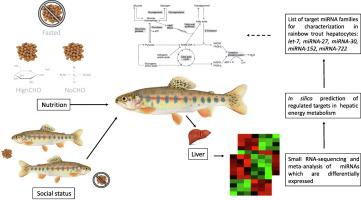Comparative Biochemistry and Physiology D: Genomics & Proteomics ( IF 3 ) Pub Date : 2020-10-03 , DOI: 10.1016/j.cbd.2020.100750 Daniel J. Kostyniuk , Jan A. Mennigen

|
MicroRNAs (miRNAs) are small non-coding RNAs which act as post-transcriptional regulators by decreasing targeted mRNA translation and stability. Principally targeting small 3′ UTR elements of protein-coding mRNAs through complementary base-pairing, miRNAs are promiscuous regulators of the transcriptome. While potent roles for hepatic miRNAs in the regulation of energy metabolism have emerged in rodent models, comparative roles in other vertebrates remain largely unexplored. Indeed, while several miRNAs are deeply conserved among vertebrates, the acquisition of lineage- and species-specific miRNAs, as well as the rewiring between miRNA-mRNA target relationships beg the question of regulatory and functional conservation and innovation of miRNAs and their targets involved in energy metabolism. Here we provide a meta-analysis of differentially expressed hepatic miRNAs in rainbow trout, a scientifically and economically important teleost species with a ‘glucose-intolerant’ phenotype. Following exposure to nutritional and social context-dependent metabolic challenges, we analyzed differential miRNA expression from small-RNA-sequencing datasets generated with a consistent bioinformatics pipeline in conjunction with an in silico target prediction of metabolic transcripts and pathways. We provide evidence for evolutionary conserved (let-7, miRNA-27 family) and rewired (miRNA-30 family, miRNA-152, miRNA-722) miRNA-metabolic target gene networks in the context of the salmonid genome. These findings represent important first steps in our understanding of the comparative regulation and function of hepatic miRNAs in rainbow trout energy metabolism. We propose that the identified miRNA families should be prioritized for future comparative functional investigation in the context of hepatic energy- and glucose metabolism in rainbow trout.
中文翻译:

差异分析的肝microRNA的荟萃分析确定虹鳟中间代谢的候选转录后调控网络
MicroRNA(miRNA)是小的非编码RNA,可通过降低目标mRNA的翻译和稳定性来充当转录后调节剂。miRNA主要通过互补碱基配对靶向蛋白质编码mRNA的3'UTR小分子,是转录组的混杂调节因子。虽然啮齿动物模型中已经显示了肝miRNA在能量代谢调节中的有效作用,但在其他脊椎动物中的比较作用仍未得到充分探索。确实,尽管脊椎动物中有几个miRNA十分保守,但是获得特定谱系和特定物种的miRNA以及在miRNA-mRNA靶标关系之间重新布线,都困扰着miRNA的调控和功能保守与创新及其涉及的靶标能量代谢。在这里,我们提供了虹鳟鱼中差异表达的肝miRNA的荟萃分析,虹鳟鱼是具有“葡萄糖不耐性”表型的科学和经济上重要的硬骨鱼种。暴露于营养和社会背景相关的代谢挑战后,我们分析了由一致的生物信息学流水线结合小分子RNA测序数据集产生的不同miRNA表达。在计算机上预测代谢产物的转录本和途径。我们提供了进化保守的(证据let-7的,miRNA的-27系列),并重新布线(miRNA的-30家族的miRNA-152,miRNA的在鲑鱼基因组的背景miRNA的代谢靶基因网络-722)。这些发现代表了我们了解虹鳟能量代谢中肝miRNA的相对调控和功能的重要第一步。我们建议,在虹鳟鱼肝能量和葡萄糖代谢的背景下,应优先考虑已识别的miRNA家族,以便将来进行比较功能研究。



























 京公网安备 11010802027423号
京公网安备 11010802027423号